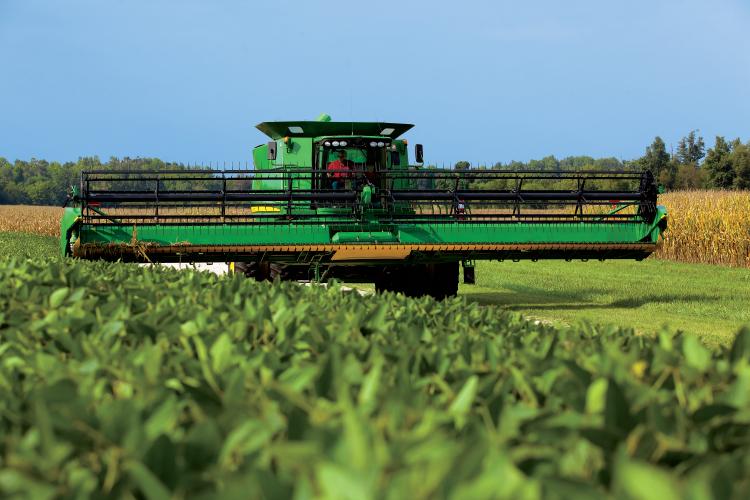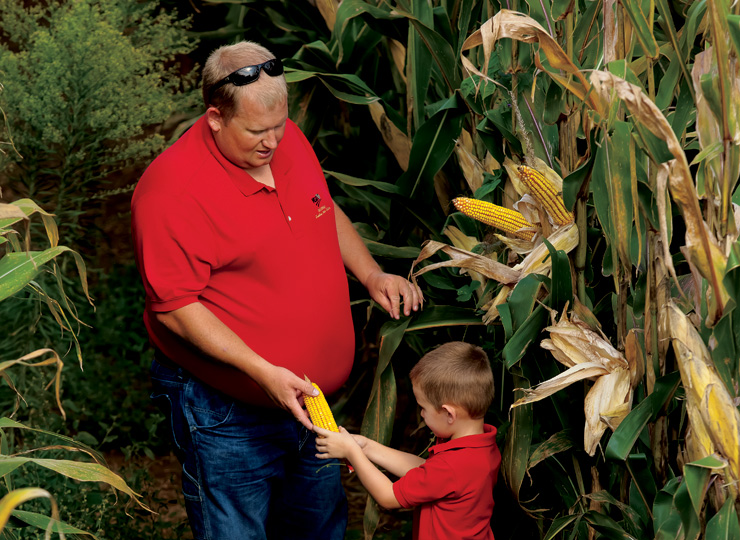Home > Kentucky > Kentucky Crops & Livestock > Corn and Soybeans Rank Among Kentucky’s Top Commodities
Corn and Soybeans Rank Among Kentucky’s Top Commodities

“Young, ambitious farmer looking for land to lease.”
That’s how Ryan Bivens described himself in ads when he moved to Hodgenville 11 years ago hoping to establish a farming career. It might be an unorthodox way to build a farm operation, since most farmers inherit a family business, but it didn’t take long for people to see how serious Bivens was, or how successful he could be.
Today, Bivens and his wife, Misty, an agriculture teacher at LaRue County High School, run Fresh Start Farms, working 5,400 acres of corn, soybeans and wheat for 68 different landlords. This year, the Bivens family was named one of the 2012 Best Young Farmers in the United States by Progressive Farmer magazine.
Fresh Start aptly describes the genesis of the Bivens’ business. Misty Bivens grew up on a tobacco and beef farm and moved to LaRue County to teach. Ryan worked for neighboring tobacco farmers in high school and college and followed Misty to Hodgenville. Growing corn and soybeans instead of tobacco was a kind of fresh start, too – one that has allowed them to do the work they love, raise their sons, Cyrus and Avery, on the farm and build a strong, community-minded business.

Top Crops
Like the Bivens family, many Kentucky farmers have had great success growing and harvesting corn and soybeans. The state’s two top crops have played a large part in the recent boom in Kentucky’s agriculture economy. Overall farm cash receipts in the Commonwealth topped $5 billion in 2011 for the first time ever.
Corn was responsible for about $980 million of that total, a close second to the poultry industry, which came in at about $1 billion. Kentucky farmers planted 1.6 million acres of corn, the largest corn acreage in more than a quarter century. Soybean production accounted for 12 percent of Kentucky’s farm cash receipts, at approximately $650 million, with nearly 1.4 million acres planted. Soybeans in Kentucky are planted both as full-season beans and double-crop beans following the winter wheat harvest.
“We’re seeing more ground that was hay pasture being brought into corn and soybean production,” says Bivens, whose operation is 50 percent corn, 50 percent beans, with half of those acres also double-crop. “Landowners see row crop production as a way to make a good return on their investment.” And, he says, Kentucky is a great place to grow those crops for several reasons.
“Our climate is a benefit because we have a longer growing window,” Bivens says. “Plus, our location creates a healthy market. We’re sitting on the Ohio River, which gives us easy access to the Gulf of Mexico and the export markets. There is also a strong market for our grain right here in Kentucky for chicken and livestock feed, distilleries and biodiesel.”
As vice president of the Kentucky Soybean Association, Bivens knows a thing or two about these markets. “Our main goal is to increase the economic return for farmers,” he says. That means maintaining and expanding existing markets and developing new ones.

All Ears
What are the challenges for Kentucky corn and bean farmers? Talk to Kentucky row crop farmers and here’s what you’ll hear: Weather, of course, is always an issue, but one that producers can do little about. Prices are another.
“Farming is not a business that guarantees a profit,” Bivens says. “We take what the market gives us.”
All the more reason to control the aspects of the business that you can, Bivens says. For him, that means a commitment to sustainable practices. “Everything we do, we look first at making decisions that are environmentally friendly. That pays the biggest dividends for everyone in the long run.”
Improved technology also helps control other aspects of farming operations. For instance, precision agriculture equipment and no-till practices have helped farmers manage the challenges growing row crops in Kentucky’s rolling hills.
“We don’t have large, square fields like they do in other states that grow corn and soybeans, so GPS technology and variable rate planting and fertilizer techniques are a big benefit for us. Automatic shutoff technology is good for the crop, good for the environment and good for the bottom line.
We’ve proven that here in Kentucky, we know how to grow these crops, grow them well and be good stewards of the land at the same time.”



